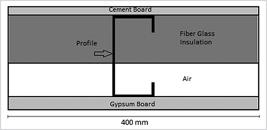Abstract
The use of steel in construction is an alternative that has changed the panorama of this sector, contributing to an increase in productivity, and a reduction in waste and construction time. The Light Steel Framing (LSF) system, introduced in Brazil at the end of the 1990s, is undergoing a process of technical development and acceptance in the national civil construction market, but there are still shortcomings regarding the design, itemization and implementation of the complementary closing systems, and also regarding its thermal performance. This study employs an analytical approach that uses the isothermal planes method to calculate the resistance and thermal transmittance, and a numerical approach that uses the ANSYS software (version 15) to verify and compare these analyses. Multi-layer closures are considered, with the outer layer being made up of cement board and the inner layer of gypsum board, brokered by fiber glass insulation and air, with studs formed by C-section profiles in galvanized steel. The isothermal planes method revealed the value of 0.77 (m2.K)/W for the equivalent thermal resistance, 1.3 W/(m2.K) for the thermal transmittance, and 13.04 W/m2 for the heat conduction flux. The difference of the results when comparing the isothermal planes and numerical solution methods was 9% for thermal resistance and 8% for heat conduction flux. The obtained results showed that the heat flux is equivalent to a value around 54% greater than the heat flux value for a closure without the presence of steel profile.
Keywords:
Light Steel Framing
; thermal resistance; thermal transmittance; isothermal planes method; numerical simulation.slate waste

 Thumbnail
Thumbnail
 Thumbnail
Thumbnail
 Thumbnail
Thumbnail
 Thumbnail
Thumbnail
 Thumbnail
Thumbnail
 Thumbnail
Thumbnail
 Thumbnail
Thumbnail








